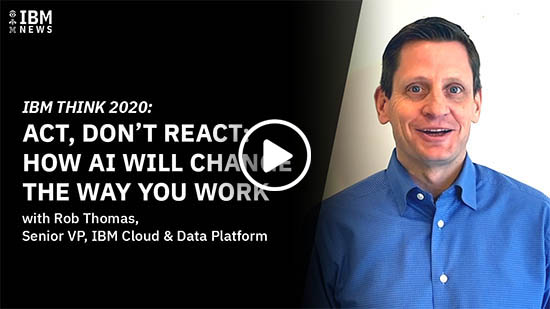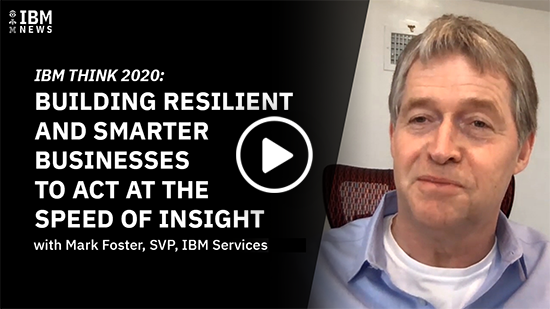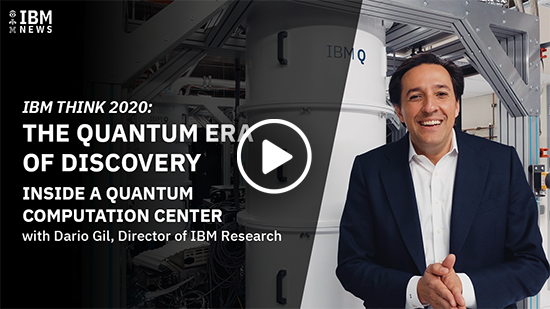THINK 2020 stories
Think Digital: Day 2 Highlights
By Greg Golden, Elissa Gootman, Ronald Gordon and Matt Hunter
May 6, 2020
The second and final day of IBM’s Think Digital virtual conference was packed with sessions illuminating innovations in artificial intelligence, 5G, cloud and other technologies—with a special focus on how these technologies are enabling companies worldwide to rise to the challenges presented by the ongoing pandemic.
On Wednesday, IBM executives gave keynote addresses and engaged in conversations with leaders from PayPal, Shell, Frito-Lay, Slack, UPS and other businesses. The conference also featured presentations by the actress and neuroscientist Mayim Bialik, who extolled the virtues of STEM education, and Bloomberg News sports business reporter Eben Novy-Williams, who explained the growing popularity of eSports. Here are some of the day’s highlights:
IBM SVP Rob Thomas: AI and Automation Move to the Fore
Companies that don’t invest in AI and cloud computing will find themselves at a profound competitive disadvantage, executives said Wednesday during a keynote presentation by Rob Thomas, Senior Vice President, IBM Cloud & Data Platform.
It’s a disadvantage the COVID-19 crisis is making all the more clear. “I like to think the crisis we’re dealing with, it’s going to accelerate perhaps what was going to happen anyway—that’s the opportunity in front of all of us,” Thomas said.
To speed that acceleration, Thomas announced a new IBM product, Watson AIOps, designed to make IT systems and infrastructures more resilient. IT downtime means lost revenue, he said. The solution lies in a combination of using AI and predictive tools not only to help prevent problems but also to fix them quickly when they occur.
Three of the many IBM clients that are already using Watson AI services joined Thomas on Wednesday to describe the benefits: Lufthansa, UPS and PayPal. So did two IBM partners: the documents management provider Box, and the collaboration software company Slack.
--------
IBM SVP Mark Foster: Businesses Adjust—To Emerge Smarter and Stronger
Even as the global pandemic is testing business resiliency, some companies are taking steps to turn the disruption to their advantage, Mark Foster, Senior Vice President of IBM Services and Global Business Services, said in a keynote presentation on Wednesday. “There’s an element of optimism emerging around how we could maybe emerge stronger from this current crisis,’’ he said, “and how we could build truly smarter businesses that will be better able to compete in the long term.”
He cited organizations that have successfully adopted digital practices in response to the pandemic. One example: A hospital chain that is using AI to help hire more than 4,000 nurses a month while working virtually. Another: A French bank that used the Watson Assistant chatbot to transform customer experiences and now is applying the technology to answer questions about the impact of COVID-19.
Executives from three IBM client companies—Yara, Shell and Frito-Lay—joined Foster to discuss how they are using technology and intelligent workflows to transform their businesses.
--------
IBM Director of Research Dario Gil: A New Quantum Era
Exponential advances in computing can help us confront world crises like the COVID-19 pandemic, as well as other big societal challenges, Dario Gil, Director of IBM Research, said in a presentation on Wednesday. Gil noted that quantum computing will complement today’s supercomputers and other classical computers to accelerate scientific discovery and technical innovation.
As researchers combat the pandemic using the bits of classical computing, another even more powerful paradigm is emerging—that of quantum bits, or qubits. “Moving forward, bits and qubits will be foundational computational paradigms with which we can tackle complex problems in the world,” Gil said.
Some of the world’s largest companies are also the most active users of IBM quantum computers, including Daimler AG, which is exploring quantum computing’s potential to develop better battery materials, and ExxonMobil, which is intent on modeling thermal reactions for use in petrochemical R&D. JP Morgan Chase, meantime, is using IBM quantum computers to create a methodology for pricing financial derivative contracts, known as options, as well as portfolios of options.
The most profound implication of what is happening today in computing, Gil said, is the convergence of bits, qubits and neural network systems that form the foundation of artificial intelligence. This convergence will be orchestrated with the help of AI-assisted programming and a hybrid cloud architecture that masks the complexity of the underlying infrastructure, Gil said.
“The consequence of all of these coming together,’’ he said, “will be nothing short of a revolution in how science itself is practiced.”
--------
Mayim Bialik on Being a Scientist and Playing One on TV
Mayim Bialik, the Emmy-nominated actress, bestselling author and neuroscientist known for her portrayal of neurobiologist Amy Farrah Fowler in the TV series The Big Bang Theory, discussed her experience with science on and off the screen. Bialik recounted how she “fell in love with science at 15,” after her interest was sparked by a tutor she worked with while starring in the ‘90s sitcom Blossom.
“She really opened my eyes to the beauty of science and also the possibility that I could learn a skill set that previously I didn’t think I was good at,” Bialik said of the tutor. These days, Bialik seeks to inspire other young people, in particular young women and girls, to pursue STEM subjects—science, technology, engineering and mathematics. “Putting a positive face on STEM is something that I’ve been happy to be part of,” she said. “Putting a positive female face on STEM is also something special, and something that I wish I had had as a young girl.”
“Even if you don’t see yourself as having a career in science, even if you don’t want to live in a lab with two other people for most of the days of your life, there is such a value to the education that you can get when you pursue STEM subjects,” Bialik continued. “Science, technology, engineering and math—those are things that touch all parts of our lives. And whether you plan to be an actor, whether you plan to be an English teacher, whether you plan to be an at-home parent, the wisdom that you get, the perspective that you get from studying these subjects stays with you forever.”
--------
Without Live Sports, eSports Become the “Ultimate Social Distancing Activity”
Because of the pandemic, the spring of 2020 is the first in decades with no traditional live sports on U.S. television. Instead, many fans are satisfying their craving by watching (or playing) eSports, or competitive videogaming. Turn on ESPN now, and you’re likely to see NBA 2K League or Madden during prime time, said Eben Novy-Williams, sports business reporter at Bloomberg News.
Though it was tiny just a few years ago, eSports has exploded in popularity, with revenue of $1.1 billion globally, Novy-Williams said during a presentation on Wednesday at Think Digital.
The dollar figure may be small compared with traditional sports, but the audience is much bigger. ESports now boasts an audience of 494 million worldwide, equal to the populations of Russia and the United States combined. That growth has largely been driven by demographics. But the pandemic—and related shutdown of traditional sports leagues—will only increase eSports’ fan base, Novy-Williams said.
“You’re seeing video games take the place of stick and ball sports,” Novy-Williams said. “It’s the ultimate social distancing activity.”
------
How McCormick Innovates New Flavors and Attracts Talent With AI
Designing new flavors is an art and a science that requires numerous data inputs and feedback. With thousands of possible ingredients, combinations and ratios, the process can take years of experimentation, manufacturing and testing. Brian Farkas, Chief Science Officer at McCormick & Company, Inc., engaged in a discussion on Wednesday with Robin Lougee, Research Industry Lead for Consumer Products and Agriculture at IBM Research, about McCormick’s use of AI to augment and accelerate the work of its human “flavorists”—and attract top talent to the company.
“AI is a huge talent magnet for us. People want to work on the best instrumentation available,” Farkas said. AI is “providing us a significant competitive advantage, in helping us to address challenges that are far beyond the ones that most people would think about,” he said. Besides helping the company develop new flavors, AI is also proving essential to McCormick’s efforts to become more agile, develop healthier products and reduce its carbon footprint.
Farkas said he sees AI becoming an important tool for helping McCormick meet consumers’ demands for mass customization. “What you like for flavors and what I like for flavors aren’t the same thing,” he said. “What if we could customize for each person? Then how do we then deliver that to the consumers?”
--------
Muriel Médard: Fulfilling the 5G Promise
Muriel Médard, past president of IEEE, is a professor at MIT, where she leads the Network Coding and Reliable Communications Group. In a Think Digital presentation on Wednesday, Médard described the emergence of 5G wireless communications as a potentially confusing but also exciting opportunity for service providers. The industry already offers an array of options including 4G, initial 5G, WiFi, enterprise networks, bespoke networks, IoT and satellite networks.
5G is seeking to be an umbrella of vertical integration across all those technologies, Médard said, with the possibilities ranging from providing connectivity to under-served rural communities to better traffic management in our largest cities. But to fulfill 5G’s promise, the industry needs to adopt standards and skills, she said.
“5G is both an opportunity and a challenge,’’ Médard said. “It provides for all kinds of different services. But providers need to bring together all the possible technologies—which is being done in an ad hoc way now. But it can be a great opportunity if providers up-skill and provide new services that make the investment worthwhile.”
--------

On Becoming a Cognitive Enterprise: US Bank’s Partnership with IBM
Donovan Roos, Vice President for Enterprise Automation at US Bank, and Monique Ouellette, Vice President for Global Digital Workplace Solutions at IBM, engaged in a far-ranging conversation on Wednesday about the journey to becoming a cognitive enterprise. The two leaders described how what started as a program to enhance employee engagement through better automation has blossomed into a partnership using IBM Watson's cognitive intelligence for employee self-service.
Some key lessons, according to Roos:
• Understand where you want to put your resources.
• The stronger your knowledge base, the more effective it will be with customer engagement.
• Understand your customers’ habits. Use the tools to enhance your intelligence.
• You need to have clean processes first, before augmenting those processes with AI.
• Find a good partner, one that is collaborative and curious around your process—and that wants to improve their own product through the partnership.
--------
Jane McGonigal: Games to Prepare You for the Future
As a future forecaster and world-renowned designer of alternate reality games, Jane McGonigal of the Institute for the Future focuses on how games transform the way we live our lives, and how we can use them to increase our resilience and well-being—especially during times of uncertainty. In her Think Digital talk on Wednesday, McGonigal detailed how a game she leads in her “How to Think Like a Futurist” course at Stanford University teaches players to observe their reality more closely, challenge their beliefs (no matter how closely held), and prepare themselves for change.
For her “100 Ways the Future Will Be Different” game, McGonigal said, players first think of a topic. In her presentation, she chose “shoes.”
Next, players list 100 facts about that topic. Three factual examples for “shoes” might be that shoes cost money, most people own numerous pairs, and people remove their shoes before bed.
Next comes the fun and thought-provoking part that helps players visualize a new reality, and use vision to prepare themselves for possible futures.
Here’s how it works:
• Shoes cost money. But in a future where governments track the health, fitness, whereabouts and social proximity of their citizens, government-supplied (and required) shoes might be free. How should we prepare for this possibility?
• Most people own numerous pairs of shoes. But would this be true in a new reality of remote work, or in the face of a severe global economic downturn? What about in a future where people are shamed for excessive consumerism because of its environmental impact—a future where current signifiers of status are upended? What might be some additional components of such a future?
• People remove their shoes before bed. But in areas beset by natural disasters such as the recent fast-moving fires of Australia and Northern California, sleeping with one’s shoes on during periods of disaster alert could make the difference between life and death. How might our behaviors change when we are faced with unchangeable new realities?
The goal of the game is to “think the unthinkable” and “imagine the unimaginable,” says McGonigal. Only then can we be prepared to cope with change, and work to make the world a better place.


